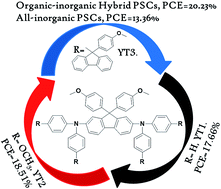当前位置:
X-MOL 学术
›
J. Mater. Chem. A
›
论文详情
Our official English website, www.x-mol.net, welcomes your feedback! (Note: you will need to create a separate account there.)
Importance of terminated groups in 9,9-bis(4-methoxyphenyl)-substituted fluorene-based hole transport materials for highly efficient organic–inorganic hybrid and all-inorganic perovskite solar cells†
Journal of Materials Chemistry A ( IF 10.7 ) Pub Date : 2019-03-25 00:00:00 , DOI: 10.1039/c9ta01452g Dongyang Zhang 1, 2, 3, 4, 5 , Tai Wu‡ 1, 2, 3, 4, 5 , Peng Xu 1, 2, 3, 4, 5 , Yangmei Ou 1, 2, 3, 4, 5 , Anxin Sun 1, 2, 3, 4, 5 , Huili Ma 6, 7, 8, 9, 10 , Bo Cui 1, 2, 3, 4, 5 , Hanwen Sun 1, 2, 3, 4, 5 , Liming Ding 10, 11, 12, 13, 14 , Yong Hua 1, 2, 3, 4, 5
Journal of Materials Chemistry A ( IF 10.7 ) Pub Date : 2019-03-25 00:00:00 , DOI: 10.1039/c9ta01452g Dongyang Zhang 1, 2, 3, 4, 5 , Tai Wu‡ 1, 2, 3, 4, 5 , Peng Xu 1, 2, 3, 4, 5 , Yangmei Ou 1, 2, 3, 4, 5 , Anxin Sun 1, 2, 3, 4, 5 , Huili Ma 6, 7, 8, 9, 10 , Bo Cui 1, 2, 3, 4, 5 , Hanwen Sun 1, 2, 3, 4, 5 , Liming Ding 10, 11, 12, 13, 14 , Yong Hua 1, 2, 3, 4, 5
Affiliation

|
Hole-transport materials (HTMs) play a crucial role in determining the photovoltaic performance and long-term stability of perovskite solar cells (PSCs), because they not only efficiently facilitate hole-extraction and transfer, but also act as a barrier to protect the perovskite from moisture and oxygen. So far, the power conversion efficiencies (PCEs) over 20% in PSCs have been mostly achieved by employing a Spiro-OMeTAD-based HTM. However, it suffers from some drawbacks such as relatively low hole-mobility, complicated synthesis and difficult purification, which hamper its potential commercial applications. Here, for the first time, two new easily accessible 9,9-bis(4-methoxyphenyl)-substituted fluorene-based HTMs comprising H (YT1) and methoxyphenyl-fluorene (YT3) as the terminated groups have been synthesized for use in organic–inorganic hybrid and all-inorganic PSCs. The (FAPbI3)0.85(MAPbBr3)0.15 and CsPbI2Br PSCs based on YT3 yield very impressive PCEs of 20.23% and 13.36%, respectively, both of which are higher than that of Spiro-OMeTAD (19.18% and 12.30%). More encouragingly, the YT3-based PSC displays good long-term stability for 600 hours. These results confirm that different terminated groups in HTMs show a significant effect on the energy levels, hole extraction and transfer, thin-film surface morphology and photovoltaic performance. Our findings could provide a useful insight for future rational design of HTMs for highly efficient and stable PSCs.
中文翻译:

9,9-双(4-甲氧基苯基)取代的芴基空穴传输材料中的端基对高效有机-无机杂化和全无机钙钛矿太阳能电池的重要性†
空穴传输材料(HTM)在确定钙钛矿太阳能电池(PSC)的光伏性能和长期稳定性方面起着至关重要的作用,因为它们不仅有效地促进了空穴的提取和转移,而且还充当了保护钙钛矿太阳能电池的障碍。水分和氧气产生的钙钛矿。到目前为止,通过采用基于Spiro-OMeTAD的HTM,大部分已经实现了PSC中20%以上的功率转换效率(PCE)。然而,它具有一些缺点,例如相对较低的空穴迁移率,复杂的合成和难以纯化,这阻碍了其潜在的商业应用。在这里,首次有两个新的易于访问的9,9-双(4-甲氧基苯基)取代的芴基HTM,包括H(YT1)和甲氧基苯基芴(YT3),因为已合成了用于有机-无机杂化和全无机PSC的封端基团。基于YT3的(FAPbI 3)0.85(MAPbBr 3)0.15和CsPbI 2 Br PSC分别产生非常令人印象深刻的PCE,分别为20.23%和13.36%,均高于Spiro-OMeTAD(分别为19.18%和12.30%)。 。更令人鼓舞的是,YT3的PSC在600小时内显示出良好的长期稳定性。这些结果证实,HTM中不同的封端基团对能级,空穴提取和转移,薄膜表面形态和光伏性能均具有显着影响。我们的发现可以为将来高效,稳定的PSC合理设计HTM提供有用的见解。
更新日期:2019-03-25
中文翻译:

9,9-双(4-甲氧基苯基)取代的芴基空穴传输材料中的端基对高效有机-无机杂化和全无机钙钛矿太阳能电池的重要性†
空穴传输材料(HTM)在确定钙钛矿太阳能电池(PSC)的光伏性能和长期稳定性方面起着至关重要的作用,因为它们不仅有效地促进了空穴的提取和转移,而且还充当了保护钙钛矿太阳能电池的障碍。水分和氧气产生的钙钛矿。到目前为止,通过采用基于Spiro-OMeTAD的HTM,大部分已经实现了PSC中20%以上的功率转换效率(PCE)。然而,它具有一些缺点,例如相对较低的空穴迁移率,复杂的合成和难以纯化,这阻碍了其潜在的商业应用。在这里,首次有两个新的易于访问的9,9-双(4-甲氧基苯基)取代的芴基HTM,包括H(YT1)和甲氧基苯基芴(YT3),因为已合成了用于有机-无机杂化和全无机PSC的封端基团。基于YT3的(FAPbI 3)0.85(MAPbBr 3)0.15和CsPbI 2 Br PSC分别产生非常令人印象深刻的PCE,分别为20.23%和13.36%,均高于Spiro-OMeTAD(分别为19.18%和12.30%)。 。更令人鼓舞的是,YT3的PSC在600小时内显示出良好的长期稳定性。这些结果证实,HTM中不同的封端基团对能级,空穴提取和转移,薄膜表面形态和光伏性能均具有显着影响。我们的发现可以为将来高效,稳定的PSC合理设计HTM提供有用的见解。











































 京公网安备 11010802027423号
京公网安备 11010802027423号